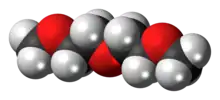Diglyme
Diglyme, or bis(2-methoxyethyl) ether, is a solvent with a high boiling point. It is an organic compound which is the dimethyl ether of diethylene glycol. (The name "diglyme" is a portmanteau of "diglycol methyl ether.") It is a colorless liquid with a slight ether-like odor. It is miscible with water as well as organic solvents.
 | |
| Names | |
|---|---|
| Preferred IUPAC name
1-Methoxy-2-(2-methoxyethoxy)ethane[1] | |
| Other names
Diglyme 2-Methoxyethyl ether Di(2-methoxyethyl) ether Diethylene glycol dimethyl ether | |
| Identifiers | |
3D model (JSmol) |
|
| ChEBI | |
| ChemSpider | |
| DrugBank | |
| ECHA InfoCard | 100.003.568 |
| EC Number |
|
PubChem CID |
|
| UNII | |
CompTox Dashboard (EPA) |
|
| |
| |
| Properties | |
| C6H14O3 | |
| Molar mass | 134.175 g·mol−1 |
| Density | 0.937 g/mL |
| Melting point | −64 °C (−83 °F; 209 K) |
| Boiling point | 162 °C (324 °F; 435 K) |
| miscible | |
| Hazards | |
EU classification (DSD) (outdated) |
Toxic (T) Flammable (F) |
| R-phrases (outdated) | R60 R61 R10 R19 |
| S-phrases (outdated) | S53 S45 |
| Flash point | 57 °C (135 °F; 330 K) |
| Related compounds | |
Related compounds |
Diethylene glycol diethyl ether, ethylene glycol dimethyl ether |
Except where otherwise noted, data are given for materials in their standard state (at 25 °C [77 °F], 100 kPa). | |
| Infobox references | |
It is prepared by a reaction of dimethyl ether and ethylene oxide over an acid catalyst.[2]
Solvent
2)cation-3D-balls.png.webp)
Because of its resiliance to strong bases, diglyme is favored as a solvent for reactions of alkali metal reagents even at high temperatures. Therefore, reactions involving organometallic reagents, such as Grignard reactions or metal hydride reductions, may have significantly enhanced reaction rates.[4][5]
Diglyme is also used as a solvent in hydroboration reactions with diborane.[6][7]
It serves as a chelate for alkali metal cations, leaving anions more active.
Safety
The European Chemicals Agency lists diglyme as a Substances of Very High Concern (SVHC) as a Reproductive Toxin.[8]
References
- Nomenclature of Organic Chemistry : IUPAC Recommendations and Preferred Names 2013 (Blue Book). Cambridge: The Royal Society of Chemistry. 2014. p. 704. doi:10.1039/9781849733069-FP001. ISBN 978-0-85404-182-4.
- Siegfried Rebsdat; Dieter Mayer. "Ethylene Glycol". Ullmann's Encyclopedia of Industrial Chemistry. Weinheim: Wiley-VCH. doi:10.1002/14356007.a10_101.
- S. Neander, J. Kornich, F. Olbrich (2002). "Novel Fluorenyl Alkali Metal DIGLYME Complexes: Synthesis and Solid State Structures". J. Organomet. Chem. 656 (1–2): 89. doi:10.1016/S0022-328X(02)01563-2.CS1 maint: uses authors parameter (link)
- J. E. Ellis, A. Davison (1976). "Tris[Bis(2-Methoxyethyl)Ether]Potassium and Tetraphenylarsonium Hexacarbonylmetallates(1-) of Niobium and Tantalum". Tris[Bis(2-Methoxyethyl)Ether]Potassium and Tetraphenylarsonium Hexacarbonylmetallates(1–) of Niobium and Tantalum. Inorg. Synth. Inorganic Syntheses. 16. pp. 68–73. doi:10.1002/9780470132470.ch21. ISBN 9780470132470.CS1 maint: uses authors parameter (link)
- J. E. Siggins, A. A. Larsen, J. H. Ackerman, C. D. Carabateasr=J. E. Siggins, A. A. Larsen, J. H. Ackerman, and C. D. Carabateas (1973). "3,5-Dinitrobenzaldehyde". Organic Syntheses. 53: 52. doi:10.15227/orgsyn.053.0052.CS1 maint: uses authors parameter (link)
- Michael W. Rathke, Alan A. Millard (1978). "Boranes in Functionalization of Olefins to Amines: 3-Pinanamine". Organic Syntheses. 58: 32. doi:10.15227/orgsyn.058.0032.CS1 maint: uses authors parameter (link)
- Ei-ichi Negishi, Herbert C. Brown (1983). "Perhydro-9b-Boraphenalene and Perhydro-9b-Phenalenol". Organic Syntheses. 61: 103. doi:10.15227/orgsyn.061.0103.CS1 maint: uses authors parameter (link)
- "Inclusion of Substances of Very High Concern in the Candidate List (Decision of the European Chemicals Agency)". 19 Dec 2011.
